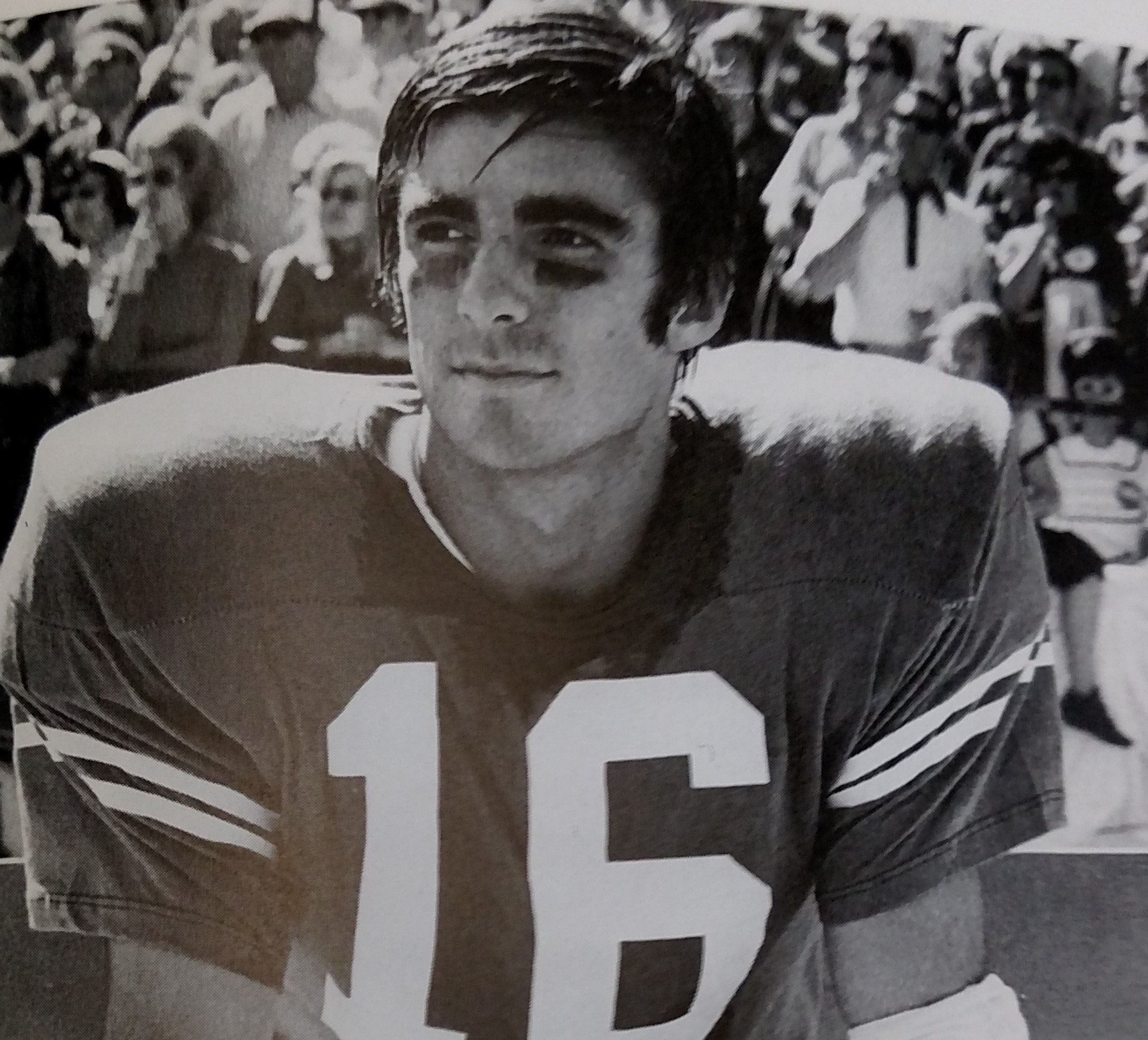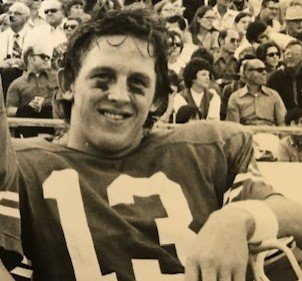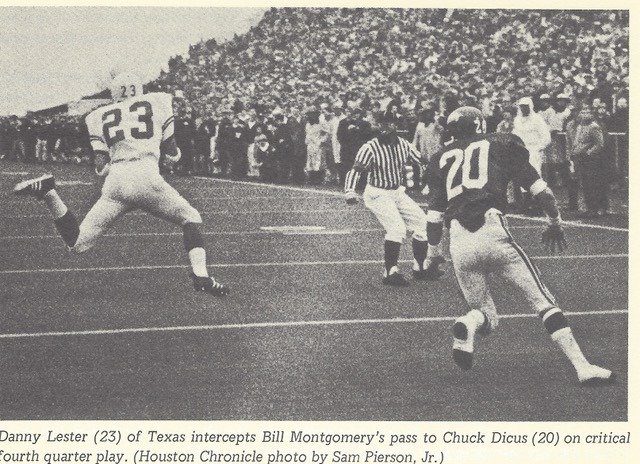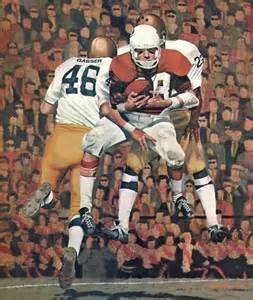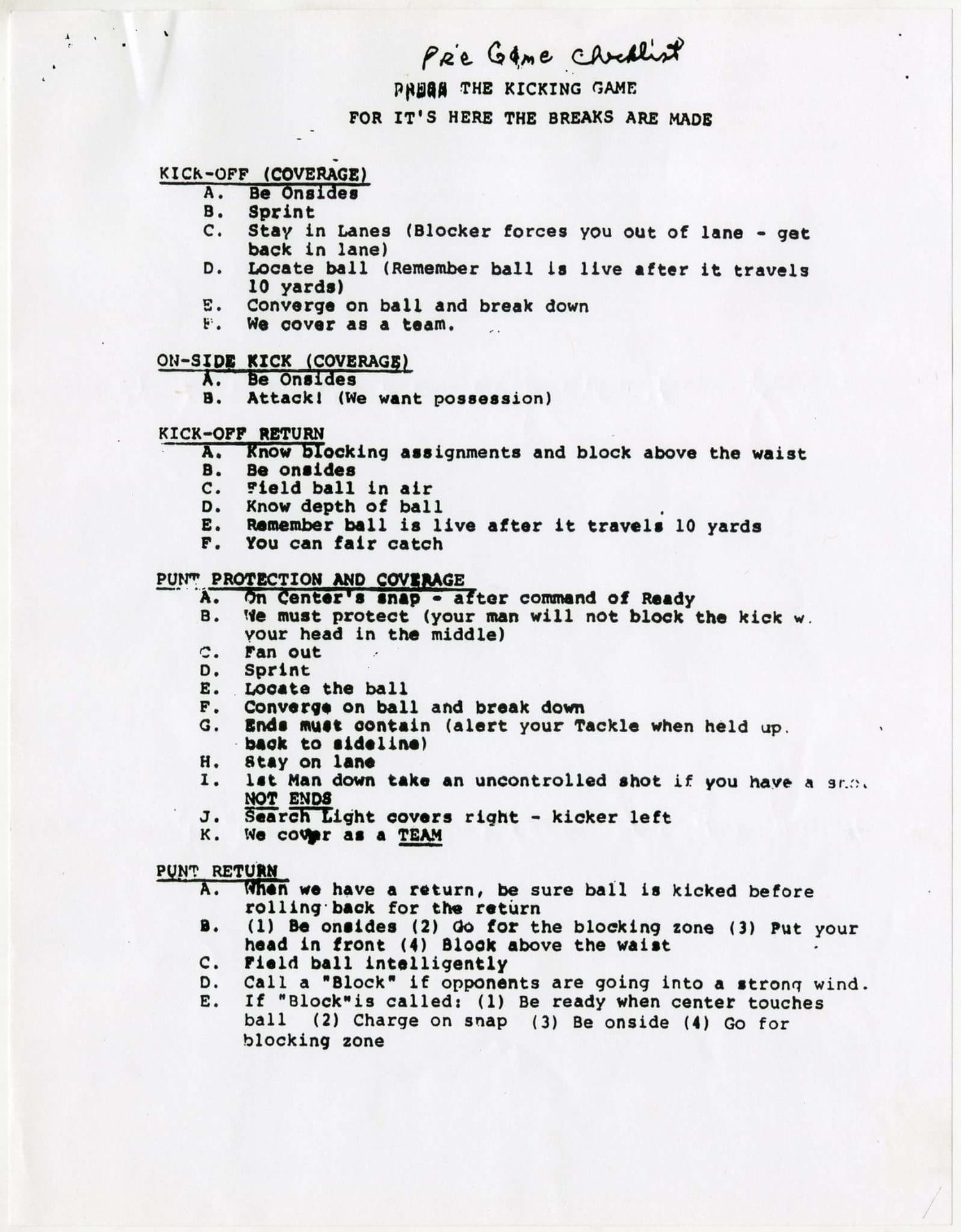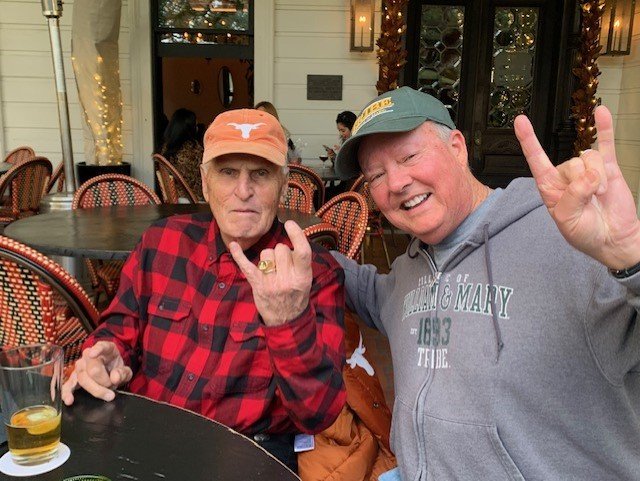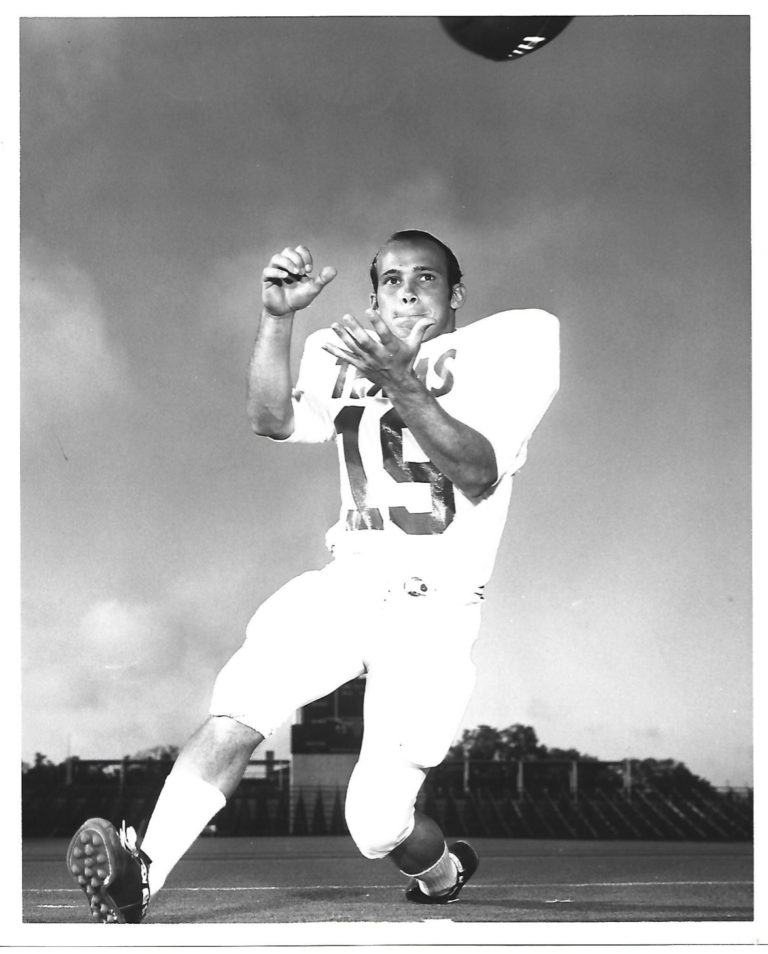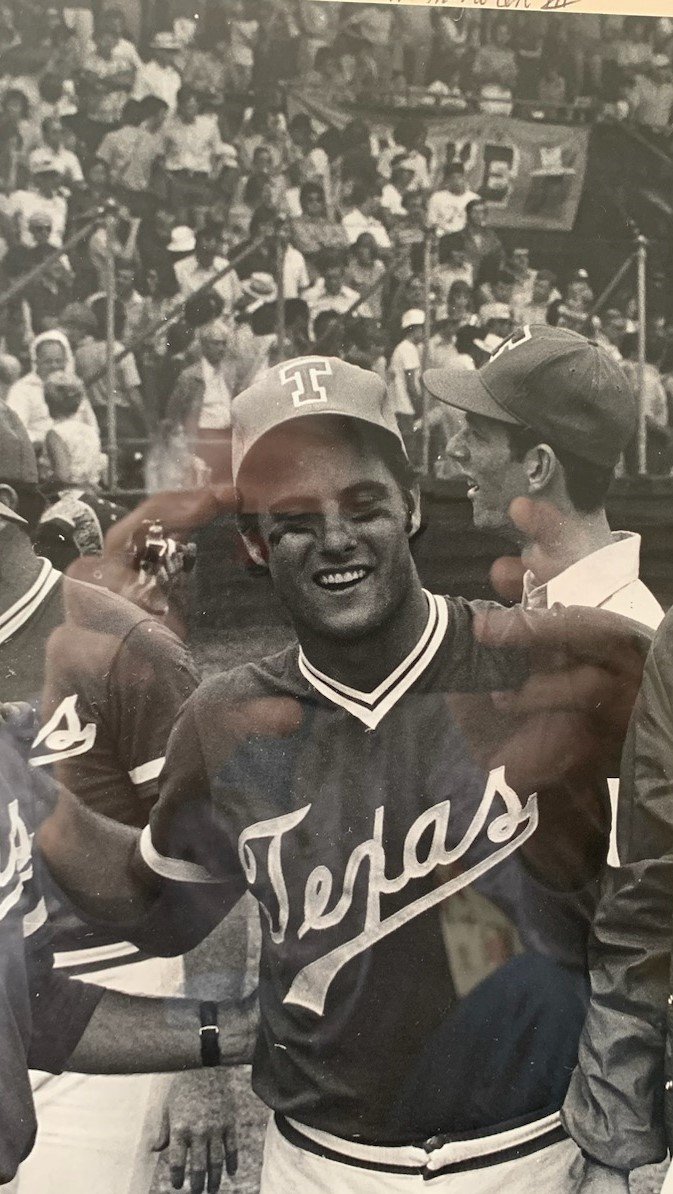Dean Campbell
Dean Cambell is #19 – Terry “Teapot” Collins is # 33.
Dean returns punt for 50 plus yards against Baylor and is congratulated by DKR.
TLSN: You know, these days, college football coaches live in gated communities or on their own private islands. You’ve described your upbringing as “blue collar,” but you grew up just a few houses down the street from UT’s new coach, Darrell Royal. Looking back, how cool was that?
In 1957, when I was eight years old, we moved to an area called Bryker Woods. It was just west of Shoal Creek and about five minutes from the UT campus. We didn’t know it then, but UT legends surrounded us. Bill Ellington and Frank Medina lived on the street that backed up to our house. Coach Russell Coffee lived about two blocks behind us. Rooster Andrews lived across the street from us. Jack Maguire, Executive Director of the Texas Ex-Students Association, lived three doors down from us, Mike Cotten lived five doors down from us, and Coach Royal lived three doors down from the Cottens. They didn’t live in our neighborhood, but Ben Crenshaw’s mother, Pearl, was my 5th grade teacher. Our area certainly had a burnt orange tint to it.
TLSN: That is way, way cool, Dean. At Texas, you were listed in the game programs as stretching the tape at 5-5 and tipping the scales at 145 pounds. Were those measurements accurate?
I would say 5-5 145 pounds would be pretty accurate. That was about the same as I was in the 9th grade. I didn’t get on the scales very often, but there were times at the end of the season when I was a little south of 140 lbs. That would be pretty rare by today’s standards, but in the sixties and early 70s, there were a lot of linemen under 200 lbs. and skill players under 170 lbs. We didn’t have strength coaches and extravagant weight rooms back then, and almost everybody went home in the summer to work in construction or the oil fields. As a result, we all reported back pretty lean, which was what Coach Royal and Frank Medina wanted. They both despised overweight players.
TLSN: I still remember Dave Campbell’s Texas Football describing you as a “zippy” split end and punt returner. You were a standout with those returns, averaging 11 yards in ’70 and almost 17 yards per return as a senior in ’71. How would you describe yourself in those roles, and what was it about your skill set and make-up that made you successful?
As a punt returner, I was not a flashy, home-run kind of guy. I’d like to think I was consistent and dependable. Coach Akers worked with me as a returner and spent a lot of time with me. We usually caught about 50 punts a day. I tried to use my quickness to make the first guy miss and then try to find a spot where I could get 10 yards. I really enjoyed returning punts. I did it at every level I played. I was OK in high school and Junior College, but I never had the success there as I did at Texas. The simple reason was I had much better players blocking for me. I had confidence in them, and they took a lot of pride in doing their job well.
Coach Royal always went over his “Press the Kicking Game” slide show before every game. Royal said, “Always field the ball intelligently.” He believed if you didn’t field the ball, it was like a 15-yard penalty because of the bounce and roll. Fielding the ball intelligently meant not fielding the ball inside the 10-yard line and running out of bounds with it or not over-extending yourself and trying to make a diving catch of the ball. Two things I hated the most were gusty winds and left-footed punters.
As a receiver, I understood that my role would be primarily as a downfield blocker. I was a small target with a very small “catch radius,” and I didn’t have the speed to be a serious threat. In ‘70, we had Cotton Speyer and Danny Lester. In ’71, we had Pat Kelly and Jim Moore. All of them were gifted athletes and receivers. Because we were primarily a running team, my goal was to be the best blocker of the bunch so that Coach Royal would want me on the field whenever it was a run.
TLSN: If you would, give us an impression of several of your all-star offensive play-maker teammates.
Donnie Wigginton – Donnie was the most unselfish player on our team. He was a backup quarterback for UT for three years, and he could have started for almost everybody else in the conference. In the Big Shoot Out of 1969, he handled a bad snap and got a cold and wet ball on the tee for Happy Feller to kick the winning extra point. In 1971, when Eddie Phillips was having hamstring problems, Donnie took over, was offensive player of the week twice, and led the conference in TDs and scoring, which was a huge reason why we won the conference championship. Donnie was a winner. Going back to his days on the Baby Oilers and all the way through high school and college. After graduation, Donnie went to A&M and coached running backs for Emory Bellard.
Eddie Phillips – The thing that separated Eddie from the other wishbone QBs in that era was that he could really spin the ball. He could throw the deep ball and he could throw on the run. He was a strong North-South runner and only Steve Worster went through more tearaway jerseys. Eddie was a blue-collar, hardworking, leader by example kind of guy who was respected by everybody. Eddie reminded me a lot of a QB we had at the Air Force Academy named Mike Thiessen. Eddie would have fit well in the spread offenses of today.
Steve Worster – Steve was one of the toughest human beings I’ve ever been around. Every Sunday morning in the fall he looked like and felt like he had been in a car wreck the day before. But he always answered the bell when we put the pads on again on Tuesday. He was the key to UT going on that famous 30 game win streak. The “Worster Bunch,” as his recruiting class was called, lived up to all expectations. Steve had a dry wit and a quiet personality, and he put on his hard hat and went to work every day. He ran kinda high kneed and flat-footed, and he would rather run over you than around you.
Cotton Speyer – Cotton was what I called “wiry.” He was very lean but had a lot of natural strength and was very explosive. He had the quickest feet I had ever seen. He could go from standing still to full speed in about three steps. He reminds me of two other Longhorns, James Saxton and Xavier Worthy. Cotton was a great route runner and had great hands. Cotton had the home run ability. In 1970, Cotton was my Friday night roommate until he broke his arm against OU. Losing him was a huge loss for our team. He always encouraged me when I was a walk-on trying to find a spot on the team.
TLSN: What were some of your favorite hangouts for food and unwinding while you were playing at UT?
When I was growing up in Austin, I had a close friend whose dad owned and operated Dirty’s. There were a lot of weekends that I spent time working at Dirty’s cutting lettuce and tomatoes and peeling onions. We didn’t get paid anything, but when we got finished, it was all-you-can-eat burgers, fries, and shakes on the house. When I was in school at UT, Dirty’s was usually my go-to on Thursday nights after studying. Growing up, I spent a lot of time at Pitch and Putt and a lot of time at Muny. I loved playing golf then and still play a couple of times a week.
TLSN: You’ve said you knew early on that you wanted to go into coaching. You ended up working with three of your Longhorn coaches, Fred Akers, Emory Bellard and Spike Dykes. But as a young man, what would be some of the lessons from DKR that particularly influenced you and stayed with you as a coach?
There were a lot of things that Coach Royal did that I carried with me into coaching. One was to keep things as simple as you could. He would rather do a few things well than do a lot of things just average. Plus, if you’re not having to spend a lot of time on different schemes you can spend more time on fundamentals and techniques. When I was coaching at Texas for Coach Akers, Mike Campbell would come to my office on Thursday mornings to visit and talk football. I had grown up with Tom, Mike and Rusty so I had known Coach Campbell since I was six years old. Coach Campbell told me a story one time that shows you how simple they kept it while he was coaching there. Back then, they didn’t trade film, so someone on the staff had to go scout. Coach Campbell’s teams to scout were OU and A&M. He told me he would see OU and A&M play three time in person before they played them. I asked him who called the defense at the Texas games in his absence. He said “Nobody, we just had one defense from goal line to goal line, but if they got inside our five-yard line we would take out a safety and put in another line backer and the defense would just do that on their own.” Texas ran an eight man front with 3 deep zone coverage behind it. So, they got really good at doing one thing. Then a few years later Texas started seeing some teams playing a 2 deep coverage in long yardage situations and Coach Royal asked Coach Campbell if he thought that was something that maybe they should look at doing So they decided they would install it and teach it. Coach Campbell said “I never scouted again. Now that we had two coverages, Royal wanted me there to decided which one to use.”
Coach Royal went to the flip-flop offense where he would flip the line and they had a strong side (to the TE) and a weak side (away from the TE). This cut the teaching of the blocking assignment in half. So, I learned from him to do a few things and do them well.
Next was the importance of the kicking game and if you are going to tell your players how important it is, you better show them by the time you spend working on it and the personnel you put on those teams. When we went to the hotel on Friday night at Texas, we only had one team meeting and that was about a 45-minute meeting on the kicking game on Saturday morning. He wanted to make sure we were all on the same page.
Another thing I took was the importance of pride. Coach Royal believed if it didn’t hurt you immensely to lose, it would be easier to give up in the 4th quarter when you’re down a couple of scores and time is running out. Coach Royal taught pride carried over from football to all areas of your life and everything you do; you are representing the University of Texas; the way you act, the way you dress, keeping a fresh haircut, clipping your nails, and shining your shoes. For years, Texas was the best goal-line defense team in the country. Coach Royal always said that playing goal-line defense was simply a matter of pride.
True to his word, 7 years later, Dean Campbell was a member of the 1970 national championship team.
The last thing I will mention that he taught us is to live our lives with class, both on and off the field. Coach Royal said, “I would rather lose than play without class.” Coach Royal exemplified that after every game. He never criticized our team or said we had played poorly. He chose instead to give the other team credit for playing well. While he was Head Coach, Texas very seldom lost a home game, but on the few occasions when they did lose, Coach Royal would go to the visitors’ locker room and address their team. He congratulated them for playing well and for winning the game. Then he told them that they had accomplished something that very few teams had ever accomplished, and they should be proud of that. What a great role model he was to us when it came to displaying class.
TLSN: You coached for seven years at the Air Force Academy and were especially adept at working with the running backs. In what ways were student-athletes different there in that extremely challenging atmosphere?
The players we had at The Air Force Academy were special. They had to want to be there because it was tough, especially their freshman year. They reported for Basic Training in mid-June and couldn’t leave campus unless their parents came for a game until Christmas break. It was very similar to a minimum-security prison. Those who stuck it out and graduated will tell you that it was the greatest experience of their life. Those who left usually regret the opportunity that they missed out on. When Fisher DeBerry called me about coming there, he told me I would be coaching the most talented athletes in the country. He said they may not be physically talented, but their talents are character, intelligence, and discipline. As you can imagine, the academics were very demanding. The athletes took 20 hours a semester along with leadership training, which never ended. From 7:00 pm till lights out at 11:00, cadets had to be in their room studying or with an instructor getting tutored. They had to be mentally tough as well as physically. Those kids played as hard as anybody I ever coached. They took a lot of pride in playing games with no penalties and no turnovers. That and running the triple option, helped level the field against some great opponents.
TLSN: Spike Dykes was popular while at Texas and became a legendary head coach for Texas Tech. He was noted for being the classic good ol’ West Texas boy. What are some memories from coaching alongside him?
There’s never been a coach who was a better fit for a job than Spike was for Texas Tech. He was born in a hospital in Lubbock, right across the street from the Tech campus. He lived in a little town called Oasis, Texas, 70 miles west of Lubbock. He went to high school in Ballenger. He beat Odessa Permian twice in the same season while he was the Head Coach at Midland Lee, then was an assistant at Texas Tech. He understood how to recruit to Lubbock, Texas. He didn’t spend a lot of time worrying about not getting 5-star recruits, he found kids who were blue collar kids with great work ethic and who wanted to play at Tech. He never tried to be somebody he wasn’t. When most Head Coaches wore a coat and tie to visit a recruit’s home, Spike wore boots and jeans. He always spoke in a way everyone could understand. I was with him one time in a recruit’s home in San Antonio, and the mom asked Spike how did the players get along with each other. He said, yes mam, our players have the best “comraderism” you’ve ever seen. I’m not sure that is a real word, but she figured out what he meant.
Spike never had an agent, and his handshake was good as gold. He loved kids, and he believed coaching was a calling. People loved to have Spike come speak at their high school football banquet. He could never turn anyone down, and he never cashed a single one of their checks.
TLSN: Dean, looking back, what changed most about coaching…or about the players, in your almost four decades of coaching up D-1 college guys?
Gosh, so much has changed about the game, and to be honest with you, I’m not sure if many of the changes were for the better. We’ve gone from playing ten games, possibly 11 if you made it to a bowl. Now we play 12, possibly 15 if you make the playoffs. I think there were maybe eight bowl games when I was playing, so you had to be really good to go to one. Now we have so many bowls they allow schools to go with losing records.
It used to be if you transferred to another school, you had to lay out a year, and you would lose a year of eligibility. Now, you see kids playing for 3 or 4 different schools during their careers. We used to have to work all summer to have some money to make it through the school year. Some of our players are making more money playing football than the professional players. NIL is no longer just a way for an athlete to make a little money. It has become the number one recruiting tool for colleges, and the rich are going to rule. With realignment, we see conferences with 16 teams in 12 states. I know it’s all money-driven, and TV controls everything. I loved coaching college football, but honestly, I’m glad just to be a spectator now.
TLSN: You elected to move back to Austin after all those years and then ended up coaching at Hyde Park. What was most rewarding about playing such an important role with high schoolers?
Growing up, I always wanted to be a coach. I thought I would start out as a high school coach, but instead, I finished my career as a high school coach. I loved every minute of it. I might still be doing it today if it wasn’t for my 160-mile round trip every day. When I took the job at Hyde Park, we had some land in Llano that we had built a small house on, so we moved there permanently, and I commuted to Austin. The people at Hyde Park were great, and we made a lot of lifelong friendships. I think the thing I enjoyed the most was getting to know the families of all our players. In college, you just got to know the families of the players you recruited.
Coach Dean Campbell with Hyde Park linebacker Dax Benkendorfer and Coach Stan Mauldin
One of the things I really enjoyed was having my former Longhorn teammate Stan Mauldin on our staff. Stan was a great asset to me since he had been a longtime high school head coach. Stan has a great football mind and the kids loved him. We also had Keoni Akina, son of longtime Longhorn assistant Duane Akina. It was Keoni’s first coaching job. He is now the offensive coordinator at the newest school in Buda. Coaching 15–to 18-year-olds is very different from coaching college kids. Having a lot of patience was my first prayer every day. I think the most rewarding part was getting to see some scared, unsure, timid 9th graders who were maybe playing football for the first time turn into confident and determined leaders of their football team and then graduate from college and become outstanding husbands, fathers, and leaders in their communities.
TLSN: To follow up on all that time in coaching and to wrap up the interview session, what do you enjoy doing these days in addition to working on your memoirs?
We live on a small ranch a couple of miles outside of Llano. We built a home there when I retired from the University of Arkansas and took the job at Hyde Park. We have a Bed & Breakfast on the property, which my wife, Cindy, runs. We have a small herd of longhorns that I enjoy working with. I’ve been on the Llano School Board for several years and served as an elder at our church. I’m involved with several Bible studies. One of them is through an organization called Coaches’ Outreach. We meet once a week with coaches at Llano High School. I have a good friend, David Willmann, our bank president, who shares the teachings. Cindy also leads a study for the coaches’ wives. I have a good friend, Joel Gotcher, who was a longtime high school football coach who moved here when he retired, and we play golf together, usually twice a week. Cindy and I enjoy traveling and doing some bucket list things. Last year, we went to the Army-Navy game, and this year, we went to the Pro Football Hall of Fame induction. We’ve been to Europe and Israel and all over the United States. We have two children: Cris, our daughter, lives in Boerne with her husband, Chad Yarbrough, daughter Campbell (12), and son Boone (7). Our son, Scott, and his wife, Noelle, live in Stephenville with their son, Conway (8), and daughter, Cambry (5). Scott is also a coach at Stephenville High School.
By far, our favorite thing to do is to spend time with our kids and grandchildren. We’ve been to soccer, cross country meets, volleyball, flag football, dance recitals, and grandparents’ days. We pick a destination spot every summer and take a family vacation together.
TLSN: Thanks a million, Dean. We’ll figure out a lunch soon. Count me in on buying a copy of your memoirs.


